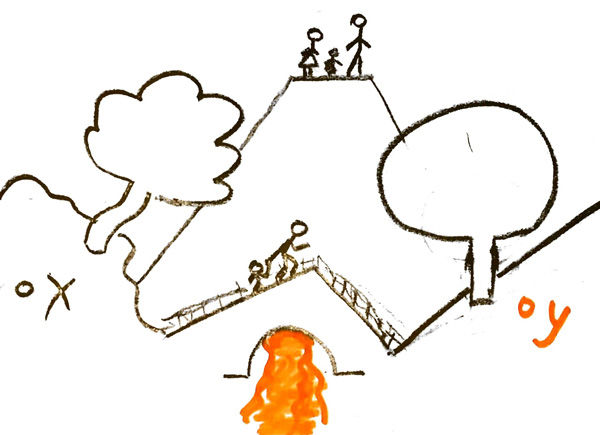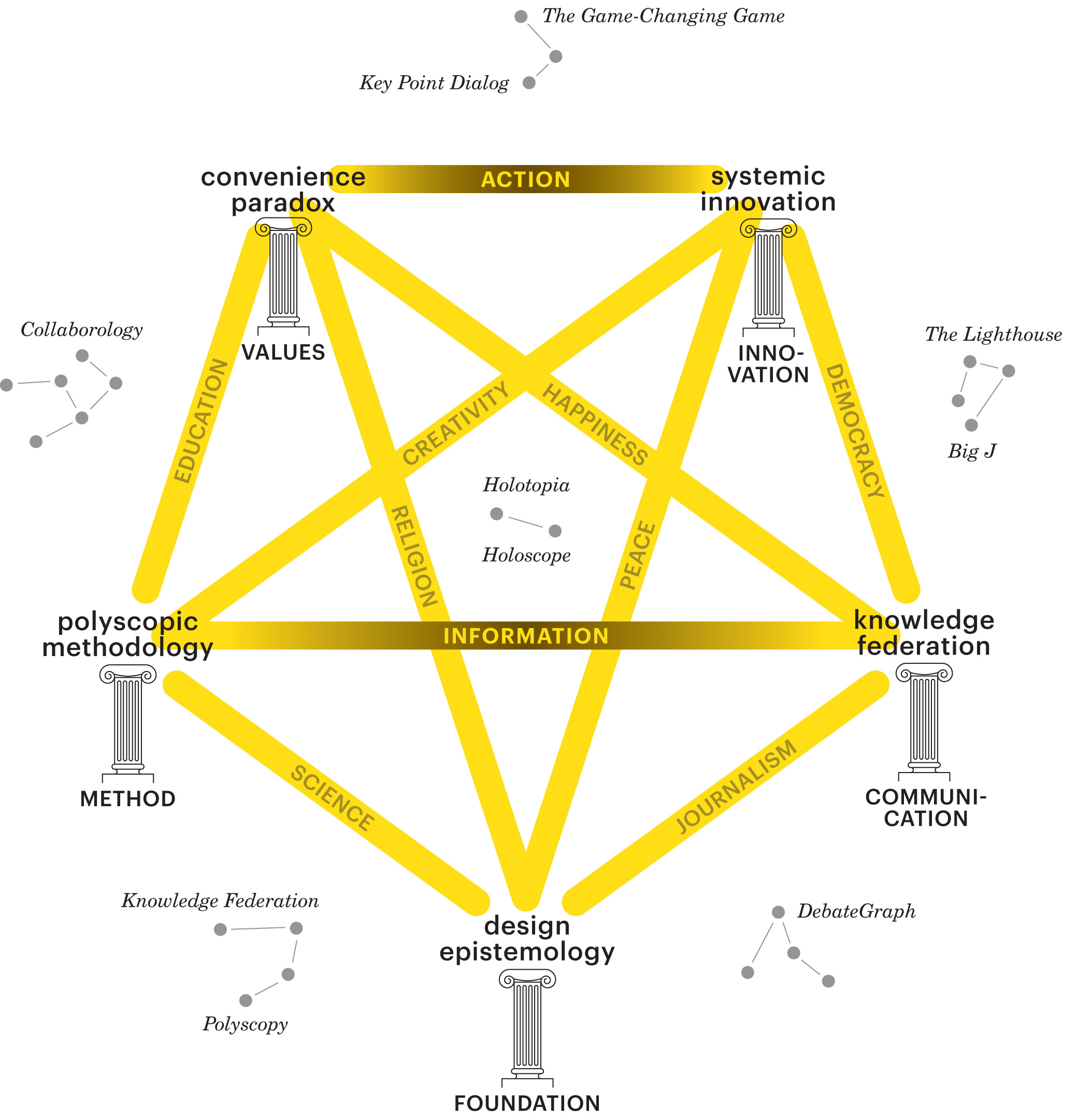Difference between revisions of "N-ideograms"
m |
m |
||
| Line 5: | Line 5: | ||
<div class="row"> | <div class="row"> | ||
| − | <div class="col-md-3" | + | <div class="col-md-3"></div> |
<div class="col-md-7"> | <div class="col-md-7"> | ||
| − | <p> | + | <p>According to dictionary definitions, ideograms are pictures that represent ideas; but <em><b>knowledge federation ideograms</b></em> are a lot more—they stand for communication; for the multimedia techniques that will empower us to communicate the point of it all; condense "one thousand words" to a single point—and make it clear and palatable.</p> |
| + | |||
| + | <p>Here I illustrate this technique by three examples; which will also explain—in the language of <em><b>ideograms</b></em>—the substance of <em><b>knowledge federation</b></em> initiative. | ||
</div> | </div> | ||
| Line 17: | Line 19: | ||
<div class="row"> | <div class="row"> | ||
| − | <div class="col-md-3"><font size="+1"> | + | <div class="col-md-3"><font size="+1">By representing the modern culture as a bus, and its <em><b>information</b></em> as its candle headlights, the Modernity ideogram depicts the <em><b>knowledge federation</b></em> initiative in a nutshell.</font></div> |
<div class="col-md-7"><h2>Modernity ideogram</h2> | <div class="col-md-7"><h2>Modernity ideogram</h2> | ||
| − | <p> | + | <p>Why we are not sustainable; and how to "change course". Aurelio Peccei wrote "Must change course". Now here's how—change the 'headlights'!</p> |
| + | |||
| + | <p>Also illustrates <em><b>design epistemology</b></em> and <em><b>systemic innovation</b></em> as new fractal; were our task is to self-organize and <em>be</em> new 'headlights'. And in this way become "sustainable". | ||
<!-- ANCHOR --> | <!-- ANCHOR --> | ||
| Line 35: | Line 39: | ||
<div class="row"> | <div class="row"> | ||
| − | <div class="col-md-3"><font size="+1">Knowledge | + | <div class="col-md-3"><font size="+1">The Knowledge Federation ideogram shows the principle of operation of the 'lightbulb', what makes it work: Instead of <em>reifying</em> our ideas—we create them as a distinct realm; and use them for orientation.</font></div> |
<div class="col-md-7"><h2>Knowledge Federation ideogram</h2> | <div class="col-md-7"><h2>Knowledge Federation ideogram</h2> | ||
| − | <p> | + | <p> The Knowledge Federation ideogram shows two banks of a river joined by a bridge; and there’s a mountain with some stick-figure humans on top in the background. |
| + | |||
| + | The left bank of the river, drawn as a curvy downward slope with a curvy tree, represents the realm of experience; or what’s called “the real world”. | ||
| + | |||
| + | The right bank of the river, drawn as a simplified and abstracted mirror image of the left bank (the river bank is a straight line; the tree is a rectangle with a circle on top) represents the realm of ideas; or what Einstein called “the totality of the concepts and propositions that are laid down in books”. | ||
| + | |||
| + | The bridge joining those two banks represents the methodology. | ||
| + | |||
| + | The mountain in the background suggests that the realm of ideas needs to be structured as a holarchy (as I explained in Chapter Two); or metaphorically—that information must elevate us above everyday jungleness and help us see things simply and clearly; and that we indeed need both big-picture views (showing ‘lakes and forests’) and detailed views (to help us ‘navigate through the trees’). | ||
| + | |||
| + | When we look from the mountain top we see things in proportion; we can then set priorities correctly. | ||
| + | |||
| + | The methodology ‘bridge’ makes it possible to take an issue or question—any issue or question from the realm of experience—to the realm of ideas; and theorize it, and comprehend it, and see how it may need to be handled. | ||
| + | |||
| + | We can then take the resulting insights back to the practical world—and act in an informed way. </p> | ||
<!-- ANCHOR --> | <!-- ANCHOR --> | ||
Revision as of 12:35, 20 October 2023
Contents
Ideograms
According to dictionary definitions, ideograms are pictures that represent ideas; but knowledge federation ideograms are a lot more—they stand for communication; for the multimedia techniques that will empower us to communicate the point of it all; condense "one thousand words" to a single point—and make it clear and palatable.
Here I illustrate this technique by three examples; which will also explain—in the language of ideograms—the substance of knowledge federation initiative. </div> </div>
Modernity ideogram
<p>Why we are not sustainable; and how to "change course". Aurelio Peccei wrote "Must change course". Now here's how—change the 'headlights'!</p>
<p>Also illustrates design epistemology and systemic innovation as new fractal; were our task is to self-organize and be new 'headlights'. And in this way become "sustainable".
Larger Text
<p>Text.</p>
<p>
<p></p> <p>Text</p>
Knowledge Federation ideogram
<p> The Knowledge Federation ideogram shows two banks of a river joined by a bridge; and there’s a mountain with some stick-figure humans on top in the background.
The left bank of the river, drawn as a curvy downward slope with a curvy tree, represents the realm of experience; or what’s called “the real world”.
The right bank of the river, drawn as a simplified and abstracted mirror image of the left bank (the river bank is a straight line; the tree is a rectangle with a circle on top) represents the realm of ideas; or what Einstein called “the totality of the concepts and propositions that are laid down in books”.
The bridge joining those two banks represents the methodology.
The mountain in the background suggests that the realm of ideas needs to be structured as a holarchy (as I explained in Chapter Two); or metaphorically—that information must elevate us above everyday jungleness and help us see things simply and clearly; and that we indeed need both big-picture views (showing ‘lakes and forests’) and detailed views (to help us ‘navigate through the trees’).
When we look from the mountain top we see things in proportion; we can then set priorities correctly.
The methodology ‘bridge’ makes it possible to take an issue or question—any issue or question from the realm of experience—to the realm of ideas; and theorize it, and comprehend it, and see how it may need to be handled.
We can then take the resulting insights back to the practical world—and act in an informed way. </p>
Larger Text
<p>Text.</p>
<p>
<p></p> <p>Text</p>

